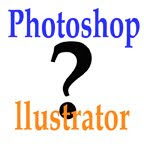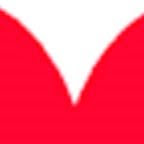 Knowing the difference between Adobe Photoshop and Adobe Illustrator can help you choose which software to use when creating and enhancing your art. Photoshop generates raster (bitmap) images while Illustrator generates vector images. Note: Scanned art is converted to raster images.
Knowing the difference between Adobe Photoshop and Adobe Illustrator can help you choose which software to use when creating and enhancing your art. Photoshop generates raster (bitmap) images while Illustrator generates vector images. Note: Scanned art is converted to raster images.Raster Images
Raster Images are composed of square dots called pixels. The more dots per inch (dpi) in an image the better the detail (resolution). If an image is scanned or created at a low resolution and later increased, the image tends to become blurry. Photoshop tries to fill in the missing pixels when the resolution is increased but it is not always successful. That is why it is recommended that you create and scan art at 300 dpi (preferred resolution for most manufacturers) or even greater.
 The example at the left shows the blurry (jaggy) edges of a shape that was originally saved at 72 dpi and then enlarged to 300 dpi. The same thing happens when a small painting is enlarge too much in Photoshop. Enlarging the design increases the size of the pixels creating jaggy edges. Thus, you should not create or scan small paintings or any painting at low resolution because when increased too much the design will become blurry. Note: All of my art is created at 300 dpi with the smallest side of the design no smaller than 12 inches.
The example at the left shows the blurry (jaggy) edges of a shape that was originally saved at 72 dpi and then enlarged to 300 dpi. The same thing happens when a small painting is enlarge too much in Photoshop. Enlarging the design increases the size of the pixels creating jaggy edges. Thus, you should not create or scan small paintings or any painting at low resolution because when increased too much the design will become blurry. Note: All of my art is created at 300 dpi with the smallest side of the design no smaller than 12 inches.Vector Images
Vector images (objects) are made up of points that are connected (paths) by lines and curves. Because the object and placement on the page is described mathematically, the resolution is not degraded when the object is enlarged. Note: Vector file sizes tend to be smaller and print faster than raster files.
Comparison of Photoshop and Illustrator
The main tool in Photoshop (brush) is more intuitive to use than Illustrator's main tool (pen). The brush and pencil tools in Photoshop works similarly to actually painting with brushes and drawing with pencils but the pen tool in Illustrator uses a different technique that requires the user to click and drag the mouse to make objects. There is a definite learning curve in producing complex shapes in Illustrator. But once you master the pen tool you can make some fantastic free-form curves (called Bezier curves) that are absolutely smooth which would be difficult if not impossible to do with the brush tool in Photoshop.
Photoshop does have some vector tools such as the text, shape, and pen tools. Because those tools are vectors, the resolution is not degraded when the objects are enlarged.
The look and the shading of images in Illustrator is also different than in Photoshop. Illustrator uses gradients of color to shade an object so art created in it looks more illustrative. Photoshop shading is pixel by pixel so art generally looks more painterly.
Hint: I have found that using the pen tool in Photoshop is more difficult than Illustrator's pen tool. So I normally use the pen or brush tool in Illustrator when I want to make smooth-edged complex-shapes such as ribbons (shown in the example at the left). By working back-and-forth between Photoshop and Illustrator, you can create some interesting and beautiful art.
When Should You Use Photoshop and Illustrator?
If you want to create 3D product mock-ups for your art, you need to use Illustrator. If your art style is painterly or you scan your art, you need to use Photoshop. If your art style is more contemporary or illustrative looking with crisp edges you may want to use Illustrator. Many artists that design patterns for the fabric industry find Illustrator better to use than Photoshop. Editing colors of objects for different colorways is easier to do in Illustrator than in Photoshop. And, if you want smooth and crisp outlines of motifs for the rubber stamp industry, templates for product development/design, etc. you will want to use Adobe Illustrator.
Check out artist Kathy Weller's blog article "Vector vs. Raster art (for children's edu illustrators or anyone who wants a good black line)" on why she uses raster applications (in her case Adobe Flash) for some of her art.
I welcome any comments or suggestions. Please write them in the comment section below.







Very helpful post! I am dealing with this issue right now. Thanks Jane.
ReplyDeleteSharon
This is a very useful post! I just wrote about this same subject on my blog too. There must be something in the air!:)
ReplyDeleteThanks for keeping this great blog-it's really informative!
Kathy,
ReplyDeleteI guess there IS something in the air! I didn't realize that you had a blog article on raster vs vector applications. I just read it and kudos to you on a well done article. I decided to edit my article to include a link to your article so other artists can read about why you use a vector application.
Joan
Hi Joan,
ReplyDeleteI'm taking a class in photoshop at El Camino College (a 2 year "Junior"College in southern California) and am going to post a link to this article on our group blog website as I think it is such a good way to learn how to differntiate the two! Thanks! Leslie
Hey THANKS for the link Joan! :) That was kind of you.
ReplyDeleteAgain great article. Loving your blog!
Thanks for such a great and informative post Joan.
ReplyDeleteI've been struggling about which one I should purchase, since it's a huge investment. I'm off to read Kathy's post.
Alison
Alison,
ReplyDeleteThe most used software by artists is Photoshop NOT Illustrator. If you are a traditional painter and scan your art (for ANY products), I suggest that you purchase and learn Photoshop. If you are an illustrator and/or want to create art ON the computer that looks illustrative, I suggest that you purchase Illustrator. Good luck!
Joan
Thanks Joan...Photoshop it is !
ReplyDeleteCheers,
Alison
I am a few months late to the party, but I just discovered your blog Joan - and it's fantastic! I'm going to pore over your Photoshop tips as soon as I get the chance. I'm an illustrator, licensing artist and Illustrator instructor, but I learn something new every day. Thanks for posting such great information.
ReplyDeleteTake care, Laura
Very informative article
ReplyDeletecartoonify yourself
Thanks, This is so helpful. Credits to the maker. Lol.
ReplyDeleteThanks for this piece of information
ReplyDeleteThank you for this informative blog. I received a wacom intuit for Christmas and I've been in a quandary over the different programs in today's market. Your explanations have answered many of my questions.
ReplyDeleteHi,
ReplyDeleteIf I want to take photos from an iphone 4s and edit them and combine them to create an enlarged print, do you think the resolution will be high enough? And is Photoshop the right program for this?
I don't know anything about iPhone but according to Apple Support Communities comments on "Changing iPhone 4S settings?" ( https://discussions.apple.com/thread/3524984?start=15&tstart=0 ) a person can get a high resolution picture by using the back camera (front camera is low resolution). One person on the thread estimated that the picture would be 10 by 8 inch at 300dpi (considered HiRes). Thus, if you combined several 10 by 8 inch pictures together in Photoshop (correct software) the image size and resolution should be high enough for most manufacturer needs. The exception may be for licensing for home decor prints since some manufacturers want very large images and at least 600dpi. The size I use for my images is 12 by 16.8 inches at 300dpi. That will reduce down to 5 by 7 inch greeting card and will be able to enlarge to approximately 28 by 40 inch at 200dpi for decorative flags (used by most flag manufacturers) with a decent resolution.
Delete